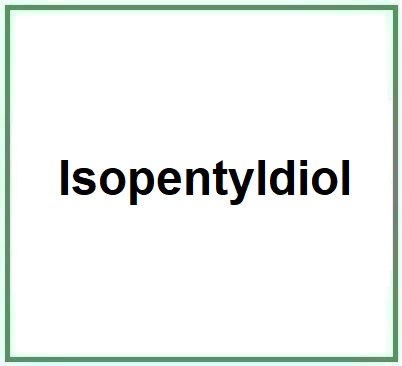Isopentyldiol is a chemical compound, a multifunctional ingredient used in various cosmetic and personal care products. It is known for its excellent moisturizing properties, skin feel enhancement, and ability to improve the stability and efficacy of formulations.
Chemical Composition and Structure
Isopentyldiol, also known as 3-Methyl-1,3-butanediol, is a diol with the chemical formula C5H12O2. It consists of a five-carbon chain with two hydroxyl groups (-OH) attached, making it a highly effective humectant and solvent.
Physical Properties
Isopentyldiol typically appears as a clear, colorless, and odorless liquid. It is miscible with water, alcohol, and various oils, making it highly versatile in cosmetic formulations. The ingredient is known for its ability to provide a smooth, non-sticky feel on the skin, enhancing the sensory attributes of personal care products.
Production Process
The production of Isopentyldiol involves chemical synthesis through processes such as the hydration of isoprene or other related chemical reactions. The process requires precise control of reaction conditions to ensure high purity and consistency in the final product. The resulting diol is then purified to meet cosmetic-grade standards.
Chemical Industrial Synthesis Process
- Preparation of reagents. The main raw materials include isopentene (2-methyl-2-butene) and water.
- Hydration. The isopentene is mixed with water in the presence of an acidic catalyst, such as sulfuric acid (H₂SO₄) or phosphoric acid (H₃PO₄).
- Hydration reaction. The mixture is heated to a controlled temperature (approximately 60-80°C) to initiate the hydration reaction, which produces isopentanol.
- Hydrogenation. The produced isopentanol is further hydrogenated in the presence of a hydrogenation catalyst, such as nickel or platinum, at controlled temperature and pressure to obtain isopentyldiol.
- Removal of water. The water produced during the reaction is removed through azeotropic distillation or by using a drying agent, such as anhydrous sodium sulfate.
- Cooling. The reaction mixture is cooled to room temperature.
- Separation. The mixture is transferred to a separatory funnel to remove the aqueous and oily phases.
- Washing. The isopentyldiol is washed with deionized water to remove any soluble impurities.
- Drying. The washed isopentyldiol is dried using a drying agent, such as anhydrous sodium sulfate, to remove residual moisture.
- Filtration. The solution is filtered to remove any solid impurities.
- Distillation. The isopentyldiol is purified through vacuum distillation to remove any volatile impurities.
- Quality control. The isopentyldiol undergoes rigorous quality testing to ensure it meets standards for purity and safety. These tests include chemical analysis and spectroscopy.
What it is used for and where
Cosmetics - INCI Functions
Solvent. It is the substance for dissolving or dispersing surfactants, oils, dyes, flavourings, bactericidal preservatives in solution.In fact, it dissolves other components present in a cosmetic formulation. Solvents are generally liquid (aqueous and non-aqueous).
Applications
Moisturizers and Lotions: Isopentyldiol is widely used in moisturizers and lotions for its excellent moisturizing properties. It helps attract and retain moisture in the skin, improving hydration and skin elasticity.
Serums and Essences: In serums and essences, Isopentyldiol acts as a solvent and delivery enhancer, helping to stabilize active ingredients and improve their penetration into the skin.
Hair Care: Isopentyldiol is used in shampoos, conditioners, and hair treatments to provide hydration, reduce frizz, and enhance the overall texture and manageability of hair.
Makeup: In makeup products such as foundations, primers, and concealers, Isopentyldiol helps create a smooth, even application and enhances the longevity and wear of the product.
Cleansers: It is also found in facial cleansers and body washes, where it helps maintain the skin's moisture balance while providing a gentle cleansing action.
Safety
Isopentyldiol is generally considered safe for use in cosmetic and personal care products when used according to recommended guidelines (1). It is non-irritating and non-sensitizing to the skin. As with all cosmetic ingredients, it is important to follow proper usage levels to ensure safety and efficacy. Isopentyldiol is biodegradable and poses minimal risk to the environment when disposed of properly.
Molecular Formula C5H12O2
Molecular Weight 104.15 g/mol
CAS 50468-22-9
UNII SKK32A493R
EC Number 256-597-5
Synonyms:
3-methyl-1,2-butanediol
1,2-Butanediol,3-methyl-
3-Methylbutane-1,2-diol
References__________________________________________________________________________
(1) Scott LN, Fiume M, Bergfeld WF, Belsito DV, Hill RA, Klaassen CD, Liebler DC, Marks JG Jr, Shank RC, Slaga TJ, Snyder PW, Heldreth B. Safety Assessment of Alkane Diols as Used in Cosmetics. Int J Toxicol. 2024 Apr;43(2_suppl):70S-131S. doi: 10.1177/10915818231224234.
Abstract. The Expert Panel for Cosmetic Ingredient Safety (Panel) assessed the safety of 10 alkane diol ingredients as used in cosmetics. The alkane diols are structurally related to each other as small diols, and most are reported to function in cosmetics as solvents. The Panel reviewed the relevant data for these ingredients, and concluded that seven alkane diols are safe in cosmetics in the present practices of use and concentration described in this safety assessment, but that the available data are insufficient to make a determination of safety for three ingredients, namely 1,4-Butanediol, 2,3-Butanediol, and Octanediol.
![]() Isopentyldiol
Isopentyldiol 


